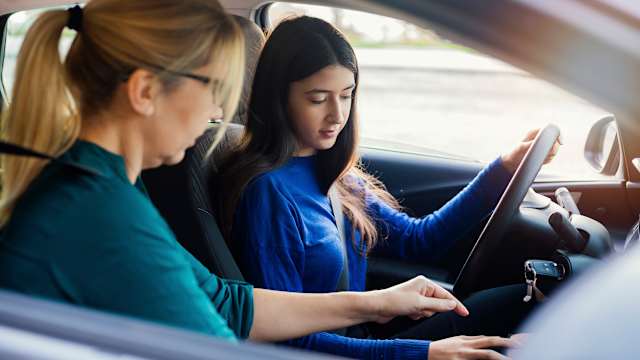Practical driving test in Switzerland
The practical driving test examines all your driving skills. If you pass, the driver's licence will be granted on probation. Comparis gives you an overview.

04.07.2024

iStock/urbazon
1. Practical driving test – what is it?
Have you passed your theory test, received your learner’s permit and gained practical experience through driving lessons? Then you’re on the road to the grand finale of your driving training: the driving test.
The expert wants to see you can handle your vehicle safely in traffic and react appropriately to different situations.
What you need to know:
Depending on the canton, the cost of the practical driving test is between 120 and 135 francs.
The test takes around 50 minutes and is examined by an expert from the Road Traffic Office.
The test is normally taken with the driving school’s learning vehicle. However, you may also use a private vehicle.
After passing the test, you will receive a probationary driving licence.
2. How do I register for the practical driving test?
Your age makes a difference:
Under 20: if you were below 20 years of age when you obtained your learner’s permit, you must gather at least 12 months of driving experience. Only then will you be admitted to the test. You can acquire the learner’s permit from the age of 17.
From 20: you don't have a waiting period. You can register for the test as soon as you feel safe.
Register for the practical driving test at the Road Traffic Office. Your driving instructor will usually take care of this.
Alternatively, you can register yourself. You’ll find instructions on the website of your cantonal Road Traffic Office (link not available in English).
Have you changed your mind after registering and now don’t want to take the practical test? Do you want to reschedule? You must report to the Road Traffic Office in good time or risk a fee. The deadlines vary from canton to canton.
3. Practical driving tests in Switzerland: overview of the process
To prepare as best you can, meet with your driving instructor about an hour before the start of the exam. You can clarify ambiguities for the test and “warm up”.
You then drive together to the Road Traffic Office where the actual exam starts.
Wait with your driving instructor until the expert calls you. After a check of your learner’s permit, you will then go together to the vehicle in which you’re making the test.
You will be alone with the expert from this point on. Your driving instructor will wait at the Road Traffic Office until the exam ends.
The practical test usually starts with technical questions. The expert might well ask:
How do you check the vehicle’s engine oil?
What is the minimum profile of a tyre by law?
How do you open the hood?
This section only takes a few minutes. You then sit in the car. The expert will inform you of the procedure of the driving test.
You will have various tasks during the driving test, for example:
Reversing
Roundabouts
Parking (forward, reverse or parallel)
Driving on the motorway
Emergency braking
Three-point turn
You will be told immediately if you have passed or not. The expert will explain their decision. The result is not open for discussion.
If you passed the test, you will receive a stamp on your learner’s permit. This shows you are now allowed to drive alone.
The stamped learner’s permit is only valid in Switzerland. To drive abroad, you need a probationary driver's licence. This usually arrives in the mail within ten working days.
4. What’s important in the practical test?
If you keep these tips in mind, you will be more likely to master the driving test:
Keep to the speed limit: keep an eye on the speedometer and road signs; adapt to the speed limits.
Use your mirrors: look in the side and rear-view mirrors regularly to note the traffic situation behind you.
Reverse carefully: visibility is restricted, so drive backwards slowly and with special care.
Indicating: signal turns early and correctly.
First look, then steer: act calmly and thoughtfully. Remember to "look, blink – and then steer".
Did you know that 2 out of 3 people pass the practical driving test the first time? Your chances are good.
But even if you have to repeat the test: don’t be down. It is often the little things that lead to success.
These tips will help:
Avoid stress: take your test in a quiet phase. Other exams or important events can increase your nerves.
Be prepared: make sure you meet the requirements. Take a few extra hours of driving practice before the test. Good preparation increases your safety and chances of passing.
Trust your driving school: your instructor will not register you for the exam until sure you are ready.
Stay positive: remember what you've already achieved.
Reduce the pressure of expectation: the fewer people know about your test, the lower the pressure.
Relax: try breathing techniques, meditation or muscle relaxation exercises.
5. You failed: what now?
If you didn’t pass the first time, you can register again. Important: you need to pay for the test yourself.
If you fail the test twice, you will need a certificate from the driving school before being allowed to sit the test again. This certifies that the driving training has been completed.
If you fail three times, you will only be admitted to a fourth test after a driving suitability assessment. This costs between 900 and 1,600 francs, depending on the canton.
If you fail a fourth time, your learner’s permit will be invalidated. To be re-admitted to the test, you will need to undergo assessment by a traffic psychologist to confirm you are fit to drive.
Common mistakes in the practical driving test
These errors often cause students to fail:
Ignoring rights of way or red lights
Using a phone while driving
Speeding
Unsafe driving
Not looking over the shoulder
Tailgating
Driving down one-way streets (the wrong way)
This article was first published on 04.07.2024





